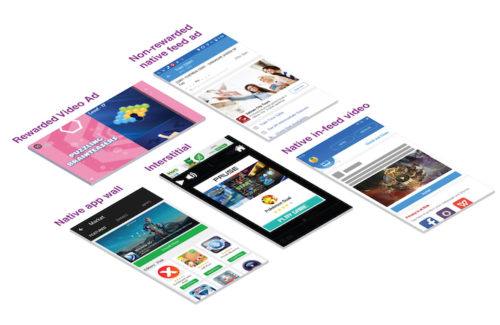From beating doctors, lawyers, drivers and even Go masters at their own jobs, artificial intelligence (AI) is due to revolutionize the way we live, work and shop.
The global AI market is projected to reach $191.60 billion by 2025. We are already seeing the impact of deep and machine learning, natural language processing and machine vision in healthcare, sales, personal assistants, education, cybersecurity, sports and our mobile phones. Artificial intelligence is all-encompassing, it’s growing and it is also having profound repercussions in our own field, mobile marketing.
How exactly is AI transforming the way we deliver and engage with ads on our phones and how are we keeping on the cutting edge of mobile marketing? Let’s take a deep dive.
China, an AI powerhouse?
China is determined to become the world’s uncontested AI power. The State Council released a roadmap in July 2017 stating it aims to create a domestic industry worth 1 trillion yuan by 2030 and it is well on its way.
China’s AI industry has attracted the most funding globally, accounting for 48% of all global investment in 2017 according to China’s AI Development Report 2018 released by Tsinghua University. That is 10 percent points ahead of the US. Worth 23.74 billion yuan ($3.55 billion) in 2017, the People’s Republic ranks first in quantity and citation of research papers and also holds the most AI patents.
In the State Council’s announcement they revealed a $2.1 billion blueprint to build an AI industrial park in the suburbs of Beijing and the Ministry of Education launched a five-year AI talent training program due to begin in April.
It’s not just the government that has caught on to the robot craze. Google, Alibaba, Apple, Tencent, the big conglomerates are all investing heavily in AI. How well their algorithms perform in the competitive field will determine the future of their business.
Mobile marketing and AI, a perfect fit
China’s prolific use of smartphones makes the country particularly well placed over the competition to lead in mobile marketing AI. 98% of Chinese users access the internet through their mobile devices, according to the China Internet Network Information Center, and they spend a significant amount of time in apps. We discussed how this has revolutionized the e-commerce market and established China as a mobile-first country in one of our previous articles.
Not only is mobile phone use prevalent in China, but data is also centralized in super apps, making the ground particularly fertile for AI technology.
Tencent’s WeChat has become the portal to the digital world. The messaging app services 1.06 million users which use it as the one-stop shop for their daily digital needs. Users can buy fashion, plan a vacation or book a doctor’s appointment all through the app. These one-stop apps are called super apps.
At Advertising Week in New York earlier this month, Tencent’s senior product director of Smart Retail, Yinyin Gao, explained how artificial intelligence is enabling new forms of connectivity and commerce for brands, marketers, retailers and consumers. With 1.06 billion users on its platforms, the impact of AI could be extensive.
“Weaving together data from mobile payments, public services, financial management and shared mobility gives Chinese companies a deep and more multi-dimensional picture of their users,” Kai-Fu Lee, the Beijing based author of AI Superpowers: China, Silicon Valley and the New World Order, observes. “That allows their AI algorithms to precisely tailor product offerings to each individual. In the current age of AI implementation, this will likely lead to a substantial acceleration and deepening of AI’s impact across China’s economy.”
A better ad experience powered by AI
Ad blockers are the enemy of online advertising. People use them to block out irrelevant and irritating advertisements online, an activity that will no longer be needed as AI begins to improve the ad experience through tailoring.
Trackers record our activity online producing data which is then crunched by AI to serve better advertisements. Algorithms weave together long and short-term interests of users in real-time to better match not just content but also the format of ads to the tastes of the user.
Matching advertisements to a user’s taste is just the beginning of tailoring. MediaGamma won a grant from the UK government’s innovation agency to develop AI that goes even further. The algorithms developed can generate text and images for the targeted ad. “We could have a banner ad specifically tailored to a person’s tastes,” says Wang, co-founder of MediaGamma.
AI in advertising improves the performance of advertiser’s content, generating great monetization efficiency and better analytics functions. Algorithms make sure that every penny of an advertiser’s budget goes only to users who are most likely to click on the ad and skips spending money on those who don’t. While this new form of automatic media buying and planning will not fully replace the manual, mobile advertising agencies are rapidly adopting AI technology in order to provide better services to its customers.
AI and Mobvista
Mobvista is no exception to this trend. We are working on big projects which keep us at the forefront of mobile marketing AI. From an automatic matching system between advertisers and users to our powerful one-stop machine-learning platform, the benefits of our AI technologies are seen across all our advertising statistics such as evaluation indexes, conversion metrics, retention and payment rates.
AI is prevalent, it is growing and there is no stopping it. There is machine learning chips in our latest phones, AI tracks and tailors our daily experiences and it is becoming the major driver of many industries around the world, including marketing.












